
KRAPETS CLIFF WALK – DURANKULAK BEACH AND MARSHES – BALGEREVO STEPPE – KALIAKRA CAPE
WEATHER: overcast to start and very windy. Some sunshine later but not much.
We had a terrific day today, we saw 100 species and added many new target birds to our list, it was great day out and we didn’t travel far from our hotel. Our morning walk before breakfast was excellent, it was a little windy but we saw a lot of birds in such a short space of time. We took the track leading from the hotel and walked parallel to the cliffs into a scrubby area with scattered bushes and mature trees further back.
A Black Redstart sang form the hotel roof and we could hear Bee-eaters, Collared Doves and a distant Song Thrush. As soon as we reached the scrub area we started noting many species, Both Common and Lesser Whitethroats sang, we saw both, Golden Orioles called we saw a female in a dead tree where two Hawfinches landed whilst we watching the oriole.

European Bee-eater - we saw many of these this morning, photo by Tony Moore
A Syrian Woodpecker was drumming and soon we had that one in the scope, then one of our prized birds arrived in the dead tree, Rose-coloured Starling, pair of them stayed for a short while. We waited and they returned a few minutes later and everyone saw them through the scope.
We had Bee-eaters flying over constantly, a large colony breeds along the cliff-face, anch picked up a Hobby flying low over a recently ploughed filed where we saw both Red-backed and Lesser Grey Shrikes, we also picked up Spanish Sparrow, Turtle Dove, Corn Bunting, Common Pheasant, Common Kestrel and then a Red-footed Falcon flew right over the top of us.
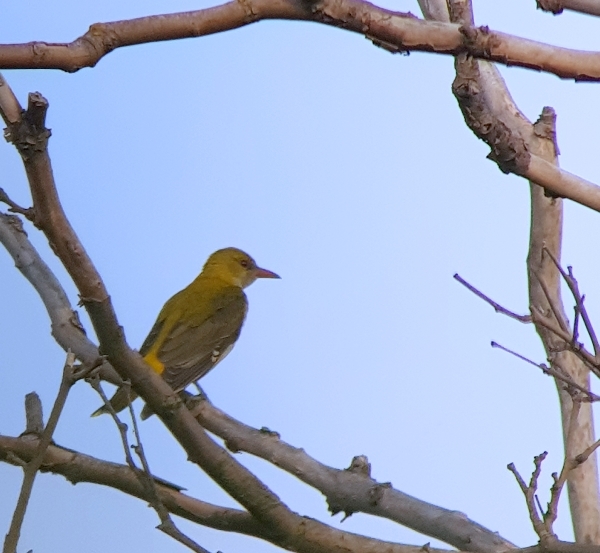
A 'green' Golden Oriole
From the cliff edge we scanned the sea, finding quite a few species, mainly gulls but also Mute Swans, European Shag, both Cormorant species, Great Crested Grebe, Common Tern and Dancho picked out an Arctic Skua! Before we returned to breakfast we found a Barred Warbler, it was singing but showed only intermittently because of the windy conditions.

two Hawfinches seen in the same tree as the Golden Oriole and ther Rose-coloured Starlings
It was a great start to our day, we saw over 30 species in less than an hour. After breakfast we drove to the reedbeds and lakes along the shore at Durankulak, just a few kilometers short of the Romanian Border. It was windy but we had high hopes of seeing our target species the Paddyfield Warbler.
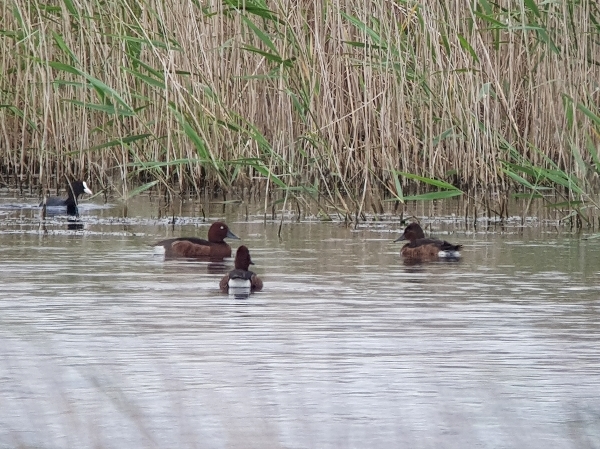
Ferruginous Ducks with a Common Coot at Durankulak Marshes
We saw several Lesser Grey Shrikes along the approach track, also Black-headed Bunting, Corn Bunting and a marsh Harrier. From the car park at Durankulak we walked to the beach and scanned the ocean and the sand. On the beach we found Little Stint, Curlew Sandpiper, Ringed Plover and on some rocks we saw two Common Sandpipers.

Lesser Grey Shrike, one of many seen today taken by Tony Moore
Out on the sea we found a flock of Yelkouan Shearwaters, they we not too far out and were feeding in a small area. Great Crested Grebes dotted the surface and gulls flew past us, we noted a Caspian Gull along the beach and Mediterranean Gulls in flight.
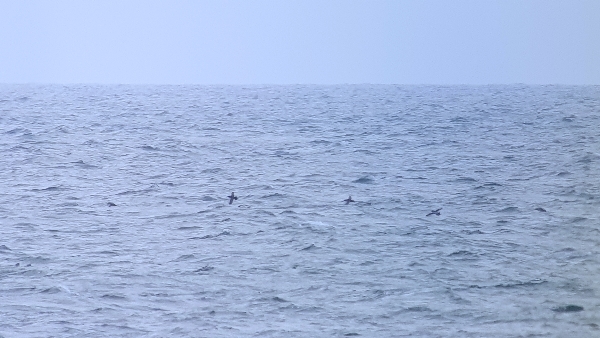
there are four or five Yelkouan Shearwaters shown here??
We spent a good two hours scanning the reedbeds, watching and listening for our target warbler but it never sang or showed. We did find Reed and Great Warbler, Cetti’s Warbler and a Tawny Pipit along the beach but we missed Paddyfield Warbler, Savi’s Warbler and Reed Bunting.
Nevertheless we had a great time watching many other species, a mixed flock of marsh terns contained all three species, Whiskered, Black and White-winged, we also saw Gull-billed Terns, Marsh Harriers, our first Levant Sparrowhawk, more Hobby and more Red-footed Falcons. A flock of some 20+ Rose-coloured Starlings flew over. There was a constant movement of Ferruginous Ducks, males chasing females, we also saw Squacco Heron, Purple Heron, Little Egret, Coot and Garganey.

Squacco Heron - Tony Moore
We then took the track along the shore back to Krapets, it was a great choice as we picked up quite few species along the way. Paddyfield, Savi’s and River Warblers all called in the same area but none of them showed, we did find Icterine Warbler in the bushes, Northern Wheatears along the shore and one stop produced great views of a Barred Warbler as it performed its display flight many times whilst we watched, a Woodlark was flying abnove us in full song too! We also searched for ‘Siberian’ Stonechat that had been reported yesterday but it had moved on.
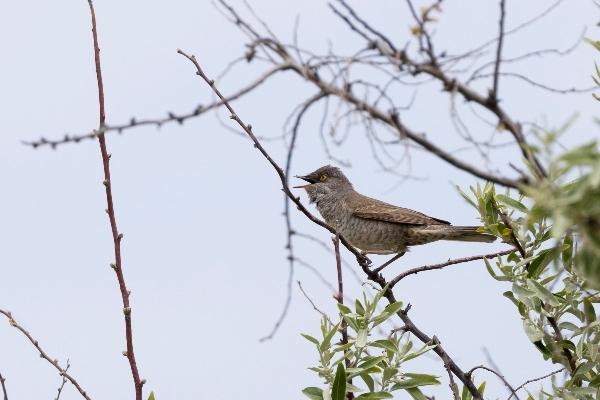
Barred Warbler - a shot by Tony Moore

my effort with the Barred Warbler
It was very late when we eventually sat down for lunch, we ate at a roadside restaurant (burger bar to be honest), we watched passing gulls as we could see the sea from our tables. Dancho pointed out three Lesser Black-backed Gulls of the ‘Fuscus’ race and he found a Black-throated Diver in Summer plumage as well as Sandwich and Little Terns.
Our late afternoon to the heath area around Balkgerevo was a very windy affair, we had spent nearly an hour in the bus driving through lanes and villages hoping for more Rose-coloured Starling feeding on fruit, we saw none but we did find Grey Partridge and Skylark, Calandra Lark
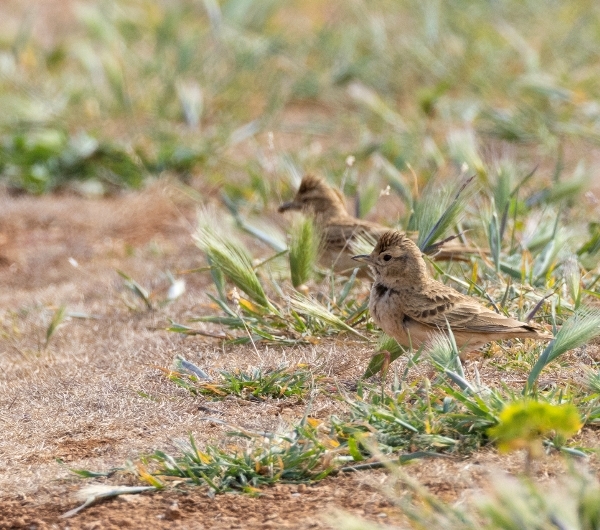
Short-toed Larks taken by Tony Moore
We had four or five target birds on the heath and we found all of them in a matter of a few minutes without walking very far. On the track we saw Short-toed Larks several of them were running around. Isabelline Wheatears flitted about in the longer grass and often perched on rock or small sticks, they also would fly up and hover over the heath (males displaying).
The large Calandra Lark seemed to be far more elusive, but they are unmistakable when seen in flight or perched on middle-distant perches, we saw plenty of them. The Stone Curlew was harder to find but we managed to see just one! We did not want to get too close to this species as they are breeding and will have chicks right now. The last target species on the heath was the Tawny Pipit, we did not see this one until we completed a circular drive around the heathland on a well worn track. Other birds seen were: Hoopoe, Bee-eater, Red-backed and Lesser Grey Shrikes, Crested Larks and many Alpine and Common Swifts flying over us.
Finally we got to Cape Kaliakra where we walked a short way along the tourist trail, through some ancient ruins to the main entrance, a stone fortification with and arched gateway. It was there that we saw Pied Wheatear, our most wanted species of the day, we saw a pair of them and they showed very well. We also saw Northern Wheatears and Dancho found our fourth Wheatear species when he spotted a Black-eared Wheatear.
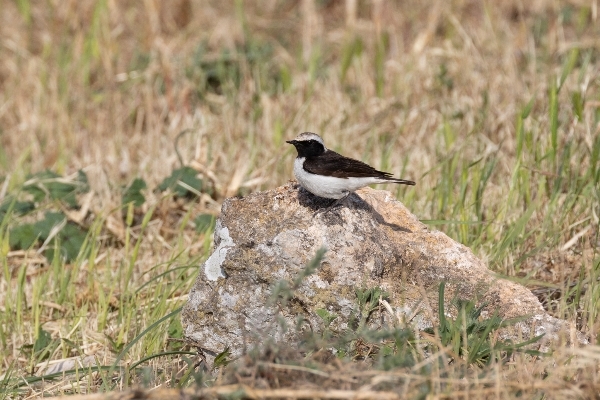
Pied Wheatear taken by Tony Moore
As we were about to walk back we saw European Shag on the rocks below us and a small flock of 20+ Rose-coloured Starlings flew past us from the headland of the Cape. Just after finishing our ice-cream in the car park we discovered a much large flock of Rose-coloured Starlings, probably 150-200 birds. Some of them flew off but a bush remained covered in them, by the time we had the scopes set up and the cameras rolling most had gone over an inaccessible ridge. We managed to get a few pictures of the remaining birds.

there are several Rose-coloured Starlings in this picture, taken by Tony Moore
That ended our birding, it was 5:30pm and we had a 45 minutes drive back to the hotel, it had been a super birding day with many new sightings and ‘lifers’ for the group.
